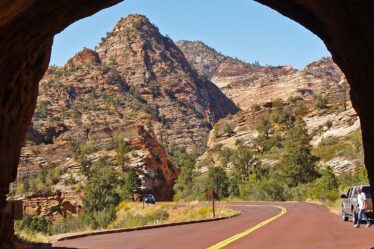
Tucked away in the scenic borderlands of Utah and Idaho lies Bear Lake, a stunning natural reservoir known for its striking turquoise waters. However, beneath its serene surface, local legend speaks of a mysterious creature that has captured the imaginations and curiosity of residents and visitors for over a century—the Bear Lake Monster. This enigmatic cryptid, often compared to Scotland’s Loch Ness Monster, has become a cornerstone of local folklore, blending history, myth, and modern-day intrigue.
The Origins of the Legend
The legend of the Bear Lake Monster dates back to the early 19th century, with the first recorded accounts emerging in the 1860s. Mormon settlers in the Bear Lake Valley, primarily those led by Brigham Young, were among the first to report sightings of the creature. The earliest and most detailed reports came from a series of articles written by Joseph C. Rich for the Deseret News in 1868. Rich, a local leader and journalist, recounted numerous eyewitness testimonies describing a large, serpent-like creature inhabiting the lake.
According to Rich’s accounts, the monster was said to be around 30 to 50 feet long, with a slender body resembling a snake or a fish and capable of moving rapidly through the water. Witnesses also claimed to see the creature’s head, which was described as being larger than a horse’s head, and its eyes, which were likened to those of a cow. These early reports sparked widespread interest and debate, establishing the Bear Lake Monster as a significant part of local folklore.
Notable Sightings and Reports
Over the years, numerous sightings of the Bear Lake Monster have been reported, contributing to the legend’s enduring mystique. Some of the most notable accounts include:
The Allen Brothers (1868)
In one of the earliest and most famous sightings, two brothers, William and Edward Allen, claimed to have seen the creature while they were out fishing. They described it as having dark blue skin and moving swiftly through the water with undulating movements. The sighting was considered credible due to the brothers’ reputation in the community.
The Scout Troop Encounter (1907)
In 1907, a Boy Scout troop camping near the lake reported seeing a large creature emerge from the water. The boys described it as having a long neck and flippers, similar to depictions of prehistoric marine reptiles. Their scoutmaster corroborated the sighting, adding a level of credibility to the account.
The Michaelson Family (1946)
In a more modern sighting, the Michaelson family, while boating on the lake in 1946, claimed to have seen a large creature surface near their boat. They described it as having a reptilian appearance with rough, scaly skin and a series of humps along its back. The family was able to observe the creature for several minutes before it disappeared into the depths.
Recent Sightings
Even in contemporary times, reports of the Bear Lake Monster continue to emerge. Local fishermen, boaters, and tourists occasionally report seeing something unusual in the water, keeping the legend alive in the public imagination. These modern sightings often describe a large, serpentine creature, consistent with historical accounts.
Theories and Explanations
The legend of the Bear Lake Monster has inspired various theories attempting to explain the mysterious sightings. These theories range from scientific explanations to more fantastical ideas.
Misidentifications
One plausible explanation for the sightings is that they are cases of misidentification. Large fish, such as sturgeon, which are not native to Bear Lake but could potentially be introduced, might account for some of the reports. Other animals, such as otters or waterfowl, could also be mistaken for a monster, especially in poor lighting conditions or from a distance.
Natural Phenomena
Some researchers suggest that natural phenomena, such as underwater currents or gas bubbles rising from the lakebed, could create illusions of a large creature moving through the water. The lake’s unique coloration and clarity might also contribute to optical illusions that fuel monster sightings.
Surviving Prehistoric Creatures
A more speculative theory posits that the Bear Lake Monster could be a surviving prehistoric creature, such as a plesiosaur or another ancient marine reptile. While this theory lacks scientific evidence and is generally considered unlikely, it remains a popular idea among cryptozoology enthusiasts.
Hoaxes and Fabrications
Given the popularity of the legend, it is also possible that some sightings have been hoaxes or exaggerations. The initial articles by Joseph C. Rich were later suggested by some, including Rich himself, to have been intended as a fun storytelling exercise. However, the legend had already taken on a life of its own by then.
Cultural Impact and Legacy
The Bear Lake Monster has become an integral part of the cultural fabric of the Bear Lake region. It has inspired books, movies, and countless articles, cementing its status as a local icon. The legend contributes to the region’s tourism industry, drawing visitors eager to explore the lake and perhaps catch a glimpse of the elusive creature.
The town of Garden City, located on the shores of Bear Lake, embraces the monster legend with various themed events and attractions. The Bear Lake Monster is featured prominently in local merchandise, from T-shirts to keychains, and the creature’s image is often used in promotional materials for the area.
Conclusion
The legend of the Bear Lake Monster is a captivating blend of history, folklore, and mystery. Whether rooted in misidentifications, natural phenomena, or something more fantastical, the tale continues to fascinate and intrigue. As long as the turquoise waters of Bear Lake shimmer in the sun, the story of the Bear Lake Monster will endure, inviting both skeptics and believers to ponder the unknown depths and the secrets they may hold.
